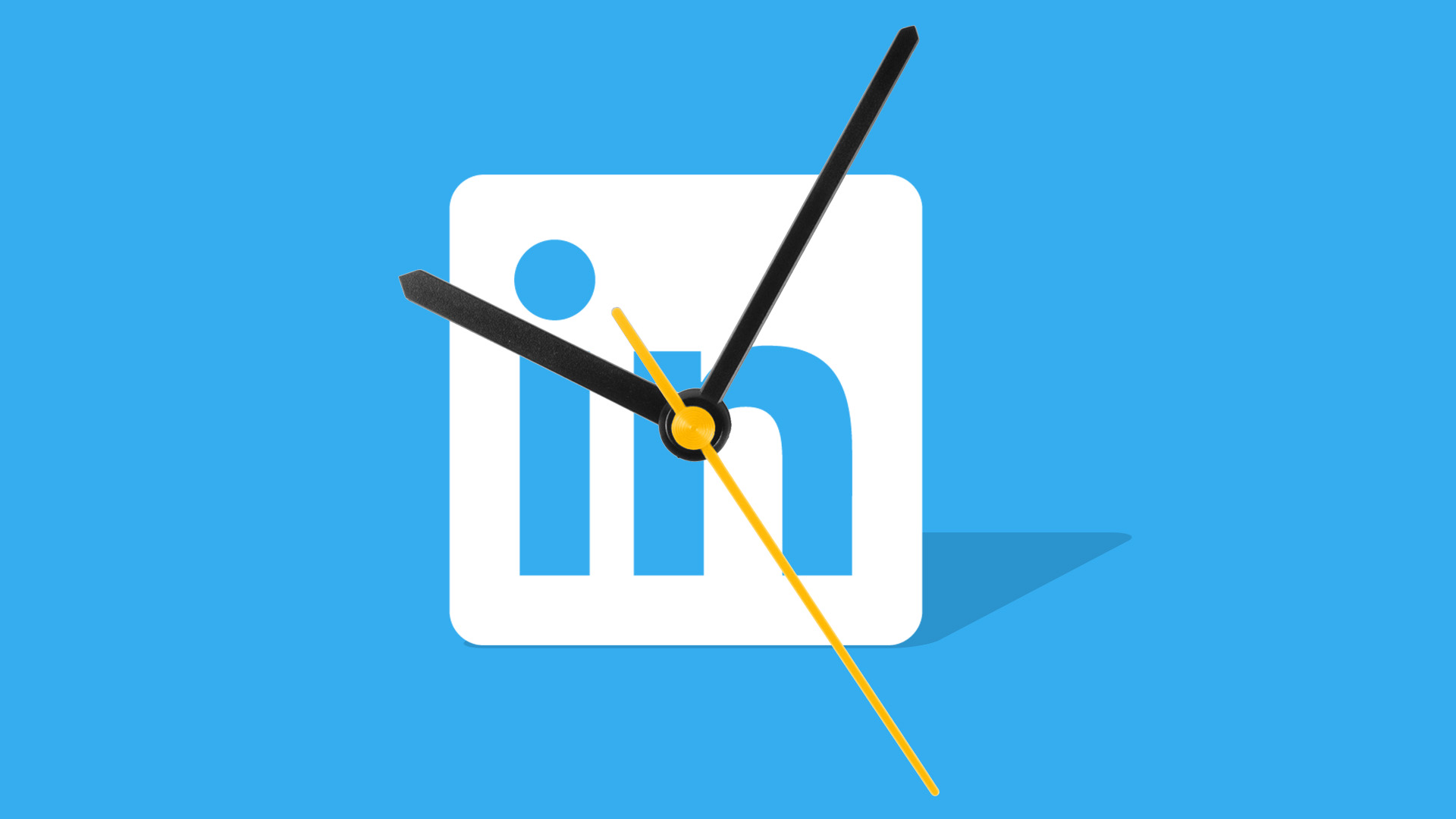When Is the Best Time To Post on LinkedIn in 2024?

You’ve put so much thought into crafting perfect LinkedIn content. It’s business-minded (in keeping with the site’s tone), but also entertaining enough to stand out in your followers’ feeds. And, of course, you’re hoping that it shows up in the feeds of others and gets shared widely. Now, all you have to do is find the best time to post on LinkedIn.
While this might sound simple, posting time can be complicated if you don’t know where to start. Let’s walk through why posting time matters and how you can make the most of it.
Does Posting Time Matter on LinkedIn?
Timing your post on LinkedIn — among many other factors — does matter.
When you share a post, the LinkedIn algorithm will show it to a smaller group of people to gauge initial interest. Then, if the post performs well there, it’ll broadcast it to a wider audience. If the post doesn’t get much engagement right away, it’s likely to stay within that small original group.
Before you dive into the finer points of LinkedIn timing, though, it’s important to understand how the LinkedIn algorithm is unique from those of other social media. (You also need to understand LinkedIn and why people are on it! Posts suitable for LinkedIn may not be right for other platforms.)
Understanding the LinkedIn Algorithm
Technically, a social media algorithm is a mathematical formula that solves a particular problem based on inputs — the data that goes in dictates what the algorithm spits out. In social media contexts, algorithms refer to the ways these platforms can filter through the millions of pieces of content and find the ones a user is most likely to engage with.
The first stage of mastering the LinkedIn algorithm is determining whether your content is high or low quality. LinkedIn uses its own signals to determine whether your content is spam, low quality, or high quality. So, be sure to keep your guide to social media ad specs on hand.
Let’s get what not to do out of the way first. Starting with: spam. Content usually gets designated as spam if it’s full of grammatical errors, has nonsensical or badly-written captions, or obviously desperate hashtags, such as #pleaselike. (Remember, #thesewillbackfire.) As you might imagine, spam is immediately weeded out, low-quality content isn’t heavily promoted, and high-quality content gets the advantage regarding its initial sharing.
“Low-quality” content, meanwhile, is any content the LinkedIn algorithm deems unlikely to pique the interest of LinkedIn users. Remember, people are there for professional tips and networking opportunities, so it’s not the place for the kinds of posts you might make on, say, Facebook.
Finally, high-quality content. These good posts are well-designed; they tag people you know, and incorporate strong keywords (in other words, they cover a topic users will actually be interested in).
So what determines whether a piece of content will be successful? Some of the various metrics (called signals) include:
- How many people have engaged with the content
- How long people are spending on your content (did they watch that video all the way through, or did they stop in the middle?)
- If your audience has shared your content with their own audience
If a piece of content does well in the early stages of showing it to that initial, smaller circle of followers — and they like, comment, and share it — the LinkedIn algorithm will continue to broadcast it to others.
So what does any of this have to do with timing? Everything.
(Okay, that was a little dramatic. But we’re not wrong.)
Timing matters when it comes to hitting your first followers. And LinkedIn’s algorithm prioritizes fresh content. So you don’t want your best ideas to get lost in a LinkedIn posting dead zone; if they do, they probably won’t be resuscitated unless you repurpose and repost that content.
The timing works in the first instance because you know your followers’ peak LinkedIn viewing times and can target them. That will be personal to your enterprise. But there is also comprehensive data you can avail yourself of to start.
Best Times To Post on LinkedIn
Thankfully, you can use data about your audience to find the best times to post on LinkedIn.
Since LinkedIn is a more professionally-minded site, posts there generally do best on weekdays (although there are always exceptions). Let’s take a look at the starting points for the best times to post throughout the week:
Monday
Research shows that 4 p.m. is the best time to post on Mondays. People are back in the office and looking for distraction inspiration to get them through the day. For this reason, many consider Monday the best day to post content.
For QuickFrame’s accounts, our best time to post on LinkedIn on Monday is between 12 and 2 p.m.
Tuesday
Similar to Monday, research found the best time to post on LinkedIn on Tuesdays is around 4 p.m. For QuickFrame, our best time to post is between 11 a.m. and 2 p.m.
Wednesday
According to Buffer, Wednesdays have the highest engagement on LinkedIn between 12 p.m. and 4 p.m. For the QuickFrame profile, our best time to post is between 11:30 a.m. and 1:30 p.m., closely aligned with the research.
Thursday
Thursday offers an engagement spike around 11 a.m., but the best time to post on LinkedIn on Thursday is at 4 p.m. For our LinkedIn profile, the best time to post is between 3:30 p.m. and 5:30 p.m.
Friday
On Friday, research suggests you’ll want to aim to post on LinkedIn around 1 p.m. For QuickFrame, our best time to post trends a bit later, between 2:30 and 3:30 p.m.
Saturday
Hold on to your social media hats — this is where the research gets interesting.
While most surveys agree that weekends are the weakest time to post and that Saturday may be the last day you’d want to consider, LinkedIn’s blog suggests the pandemic changed that.
With more people working remotely and Gen Z in the workforce, the traditional line between work days and weekends has (somewhat) blurred. The post also found Gen Z users are more likely to check their LinkedIn feed (their phones in general, really) on weekends. So if you’re targeting them, Saturday may actually be a good day to post.
Sunday
According to Buffer, Sunday is a lighter day on the platform for engagement. But if you’re dedicated to getting a post out to wrap up the weekend, the peak times are 7 a.m., 12 p.m., and 5 p.m.
Considerations for Timing Your LinkedIn Posts
Picking the best time to post on LinkedIn isn’t as easy as it sounds. There’s a lot to consider about your content and audience, including:
Time Zones
Prime time on the East Coast may be too early for the West Coast. You can generally split the difference so that you’re posting in the morning (if that’s your aim), but time zone differences still make it hard if you have target audiences worldwide. To solve this, you’ll want to understand where the majority of your audience is and schedule your content accordingly.
LinkedIn also offers other possible solutions. Certain features allow you to create posts on your LinkedIn Page to target specific audiences.
Geographic Location
Speaking of geographic locations, these also complicate your attempts to get the most eyeballs concurrent with posting. In addition to different languages, time zones, and more, users in different locales may have different patterns of LinkedIn viewing. But the more you post, the more data you’ll be able to use to craft your worldwide LinkedIn marketing strategy.
User Behavior
You know your audience best. And it’s okay if you only have broad trends at first! The more you post, the more you’ll be able to refine your knowledge of your target users.
Even within some broad data surveys, there are interesting industry-specific facts to keep in mind, such as the fact that those who work in media are more likely to read their LinkedIn feed in the morning. In contrast, people working in B2B industries are more focused than others, so they are more likely to read their LinkedIn feeds before work, at lunch, or after returning home.
Engagement Trends
As noted above, engagement trends differ by demographic (to whit, Gen Z looks at their LinkedIn a lot more often than other generations) and industry. Keep an eye on your audience’s engagement trends so you can make the most of their time on the platform.
Types of Content
LinkedIn’s blog notes that different kinds of content can provoke different engagement. Friday may look like a weak day to post, but lighthearted, TGIF-y content might do well with your audience before they head into the weekend.
Generally, video content always does better on LinkedIn, with audiences 20X more likely to share videos than other posts. So while you should time your content well, what’s most important is that your content is high-quality and visually engaging.
How To Measure Success
Before you get started, you’ll need to set goals so you can measure your success and understand where to optimize your strategy. On LinkedIn, these could involve:
- Setting benchmarks for engagement, sales, or conversions
- Establishing yourself as an authority in your field
- Expanding your network of high-value connections
It’s also important to decide why these goals matter to you. When you clearly understand your motivations behind using social media, it’s easier to refine your goals and tactics.
It’s Not a Perfect Science
The best time to post on LinkedIn won’t be the same for every business, so you’ve got to find out what works best for you. While these are great starting points, they might not be the times you post your content forever. Plus, since social media changes rapidly, you’ll need to make sure your strategy is flexible.
Use LinkedIn Analytics
LinkedIn Analytics offers handy tools to help you keep track of your digital presence. You can use LinkedIn Analytics to:
- Test benchmarks, such as your advertising return on investment (ROI)
- See how well your ads are driving conversions
- Determine how much engagement they generate through clicks, impressions, and shares
LinkedIn Analytics can also give you vital information on the makeup of your audience and who’s being inspired to visit your website from your target companies based on your LinkedIn marketing. In all, this is handy information that provides you with actionable insights.
Test, Test, and Test Some More
The only way to really know when posting is most effective is to keep making great video marketing content and see what works. This includes the content itself and distribution factors, like the timing of your posts. By testing these elements, you’ll be able to understand, for example, whether humorous animated explainer ads or serious live-action videos work best for your audience.
The more you post and test, the more you learn about your campaign and target users. Once you’ve started gathering insights, you’ll be able to optimize your strategy and make the most of your time on the platform.
Making LinkedIn Videos at Scale
The more you post, the more data you have on what’s connecting with your audience, allowing you to create more content in the same vein to best address your users’ needs. But creating quality content at that volume and then meticulously tracking how it lands is a significant amount of work.
To give your team the bandwidth it needs, it’s time to consider partnering with a team that understands the business and creative aspects behind LinkedIn videos, like QuickFrame. As a certified LinkedIn Marketing Partner, QuickFrame offers the most comprehensive video production solutions for the platform.
Ready to get started? Contact us today to learn more about LinkedIn video production.
When To Post on LinkedIn: Final Thoughts
With 1 billion users worldwide, LinkedIn offers plenty of opportunities for brands to engage with their target audiences. With the right timing, content, and platform-specific best practices, you’ll be able to reach them, create engaging content, and grow your business.
Do More with Video
Learn how we can help you produce more quality videos affordably and at scale.


